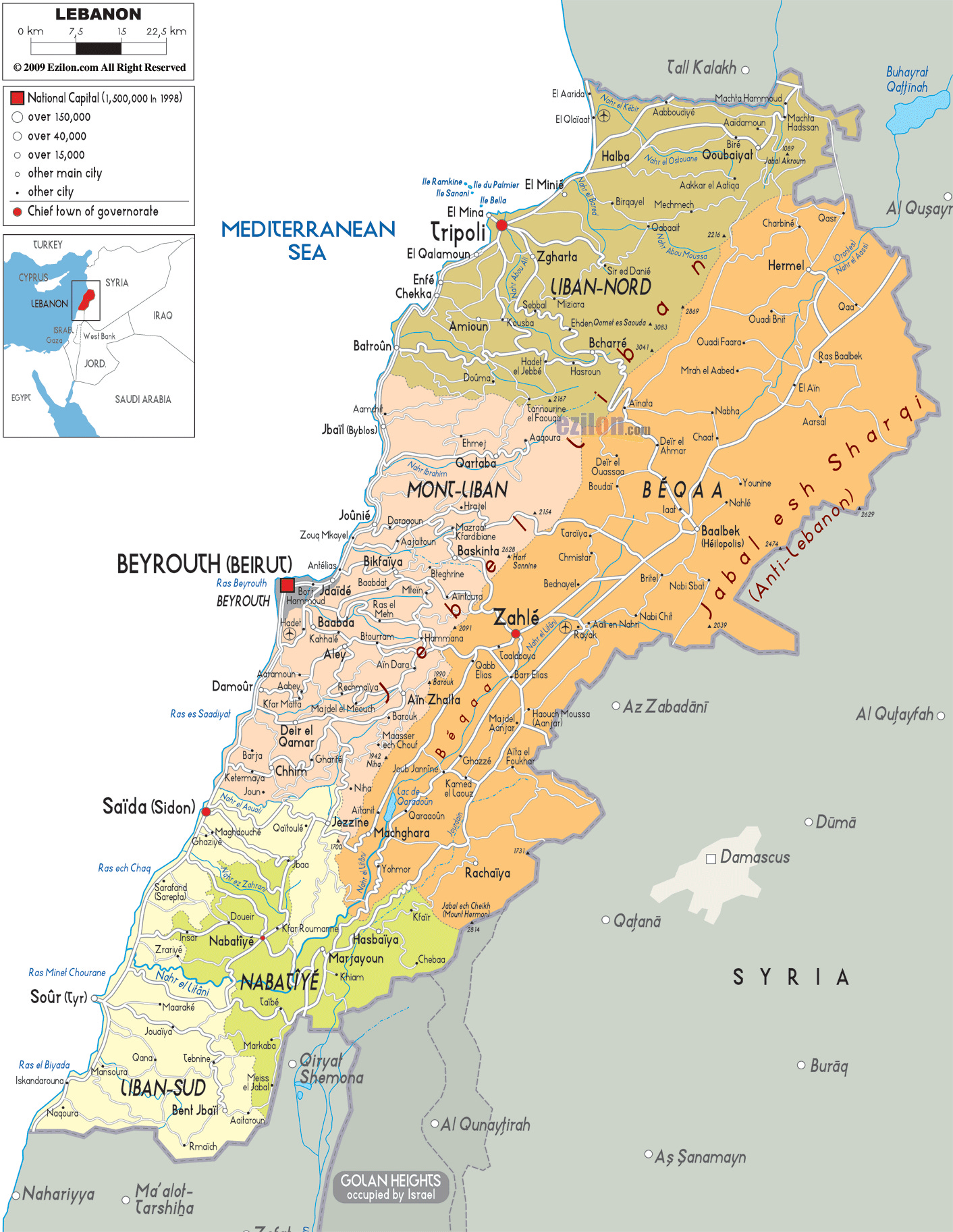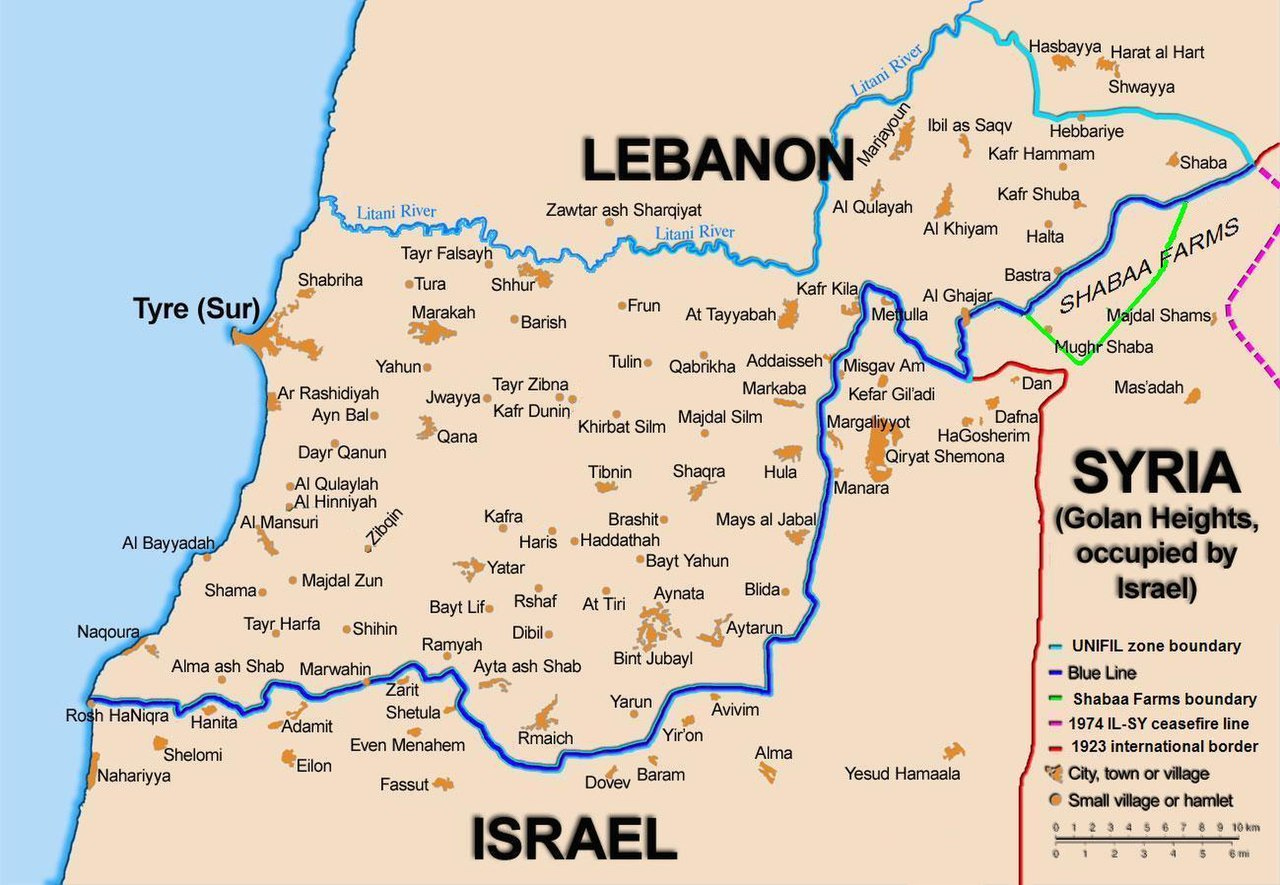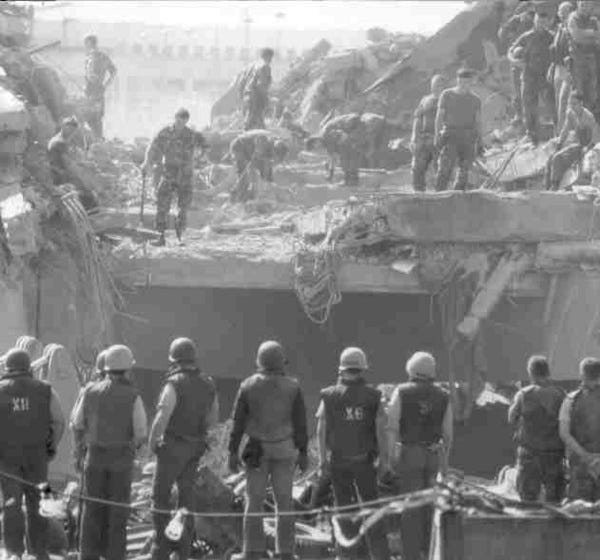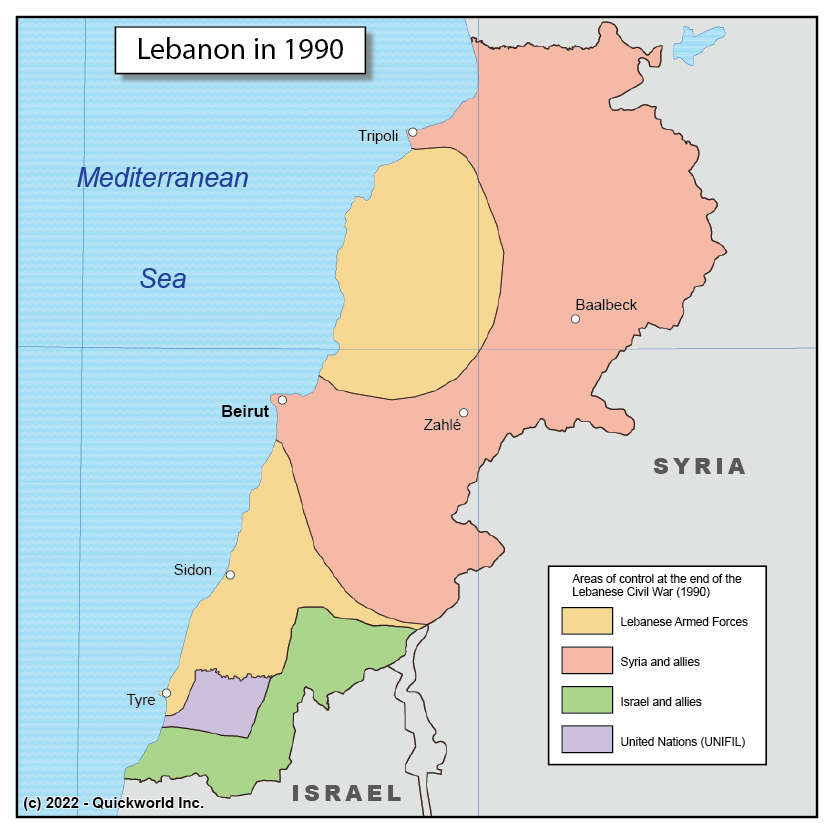Israel and Lebanon: 77 Years of Conflict
Created as a State for Christians, Lebanon Ended Up Controlled by Enemies of Israel
With Israeli troops engaged on the ground, fighting Hezbollah’s Radwan force in southern Lebanon, and an ongoing Israeli bombing campaign aimed at degrading Hezbollah’s vast arsenal of rockets and other munitions, as well as the continued targeting of the surviving senior leaders, we were moved to do some reading on the history of Lebanon over the 77 years since the founding of the State of Israel.
Israel’s wars against enemies based in Lebanon have had an important impact on Israel’s history and how Israel sees itself, particularly the power and role of the Israel Defense Forces. Here below is an brief account of the history of Israeli Lebanese relations from the founding of the State until the end of the Lebanese Civil War at the beginning of the 1990’s. The 1980’s saw the emergence of Hezbollah, an Iranian sponsored militia dedicated to Israel’s destruction, which today is the most powerful force in Lebanon. Today, Israel is at war with Hezbollah, which has loomed for many years as a potentially devastating threat, curtailing Israel’s freedom of action against Iran.
We are planning to follow up with a second article covering the years between 1990 and the present. This first part provides important background in understanding how the present situation came about. Please check it out just below.
Lebanon’s Origins as a State to protect Christians
When the Ottoman Empire was defeated at the end of the first world war, vast territories it had ruled for centuries fell under the control of the victorious European powers, Britain and France. Using the language fashionable at the time, these territories were called Mandates rather than colonies, with the European power treated as a trustee which would oversee a transition of each territory to independence.
The British obtained the mandate for Palestine and for Mesopotamia (today’s Iraq) and the French got the mandate for Syria. From southwestern Syria, the French carved out the territory which became the modern state of Lebanon. The origins of modern Lebanon date back to the 1860’s. There was a conflict in the area of Mount Lebanon between Christians and Druze, in which 10,000 Christians were killed. France intervened in support of the Christians, while Britain supported the Druze. In 1861, the semi-autonomous Ottoman province of Mount Lebanon was established, with international guarantees to protect the Lebanese Christians. Under the French mandate after the first world war, the territory of Lebanon was enlarged northward to include Tripoli, eastward to include the Bekaa Valley and southward to the cities of Sidon and Nabatiyah, and beyond toward Tyre and the border with the British Mandate for Palestine.
Image: Map of Lebanon ————Source: Ezilon.com
During the second world war, while France was under Nazi occupation, Lebanon became an independent Republic within these expanded borders, known as “Greater Lebanon". After independence, Lebanon was governed in accordance with an unwritten “national compact” which reserved the powerful presidency for a Maronite Christian. The job of Prime Minister always went to a Sunni Muslim and that of Speaker in Parliament to a Shi’a Muslim. The Lebanese army, led by Maronite officers, with a fixed ratio of troops from the three communities, was kept small due to mutual mistrust among the various religious groups.
Israel’s Origin as a State for the Jews
To the south, the British Mandate of Palestine had come with the obligation, ratified by the League of Nations, to support the creation a Jewish national home. When the British walked away from the mandate and the State of Israel was declared on May 14, 1948, Lebanon was one of five states that declared war on the brand new Jewish state. This article Lebanese Armed Forces - Wikipedia, states that the Lebanese armed forces fought the Israelis on June 8, 1948, capturing two villages and then yielding control to the Arab Liberation Army (ALA). The ALA were Palestinian Arab units that fought in the civil war in Palestine, which preceded the invasion of Palestine by the five neighbouring states the day after Israel declared its independence.
By the end of the war of Independence, Israel had pushed the Lebanese army back and occupied part of southern Lebanon. In 1949, Israel signed an armistice agreement with Lebanon and withdrew to the former border between Lebanon and the Palestine mandate. While Israel agreed to give up all Lebanese territory captured during the war, Lebanon did not agree to a formal peace and did not recognize Israel.
Lebanon’s weak army left it vulnerable to manipulation by other bigger powers in the region. This article: Israeli–Lebanese conflict - Wikipedia describes a long history describing how war against Israel led to civil war and foreign invasion in Lebanon, by both Israel and Syria. Some of this history is summarized below and is the main subject of this article.
Palestine Refugees in Lebanon
In 1949, Lebanon was home to 110,000 refugees who had fled from Palestine as a result of Israel’s war of independence. The Lebanese Christians didn’t want the mainly Muslim Palestinians to disturb the demographic balance of Lebanon, which was deemed to have a Christian majority based on a 1933 census. Palestinian refugees were prevented from obtaining Lebanese nationality and denied access to government services. They were banned from many kinds of employment. The United Nations Relief and Works Agency (UNRWA) became responsible for their needs and large refugee camps were established near Beirut and elsewhere in the country.
According to this article: Israel–Lebanon relations - Wikipedia, between the years 1949 and 1970, the Lebanese border with Israel was the most peaceful of all Israel’s frontiers with neighbouring Arab States. Lebanon did not host Fedayeen which attacked Israel in the 1950’s and did not participate in the Suez War (1956), the Six Day War (1967) or the Yom Kippur War (1973). Furthermore, the Jews of Lebanon were not driven from the country as they were from Egypt and Syria, and from the areas of Palestine that were conquered by Egypt and Jordan. The Jewish population of Lebanon continued to grow in the years after Israel’s war of independence.
Palestinian terrorist groups organized in Lebanon, especially after the Israeli victory in the 1967 Six Day War. Lebanon’s small army was unable to prevent PLO terrorists from infiltrating the country and setting up bases on the southern border, and launching attacks, as early as 1968. In 1968, terrorists of the Lebanese based Popular Front for the Liberation of Palestine (PFLP) carried out an attack on El Al Flight 253. Flight 253 was on a stopover at Athens Airport when the attackers approached the plane, killing a passenger, Leon Shirdan, 50 of Haifa, and wounding two Israeli women. The terrorists were arrested, and one was sentenced to over 17 years in prison, but released after only four months. The convicted killer was freed when Palestinians hijacked an Olympia Airways plane and exchanged it for his release by the Greek authorities.
Israel held the state of Lebanon responsible for the Palestinian terrorists operating from its soil. In response to the attack on Flight 253, Israel staged a raid on Beirut Airport, destroying a number of aircraft. The violence emanating from Lebanon in 1968 was, unfortunately a taste of much worse to come. Anti-Israel violence would eventually bring disaster to Lebanon.
Lebanese Civil War
In 1970, the Palestine Liberation Organization (PLO) which had built up armed forces in Palestine refugee camps, attempted to overthrow the King of Jordan and take over. Jordan was part of Palestine when the British first assumed the Mandate. It was the British who had handed over 80% of Palestine to King Hussein’s grandfather.
The Jordanian regime suppressed the coup attempt and expelled the leadership of the PLO from the country. Yasser Arafat and the rest of the Palestinian leadership relocated to the refugee camps in Southern Lebanon during 1970 to 1971. After that Lebanon became a battleground between Israel and the PLO.
As early as the 1950’s, divisions between Christians and Muslims had threatened to create civil war in Lebanon. Egypt’s President Nasser had advocated for a unified Arab Republic (UAE) and sent armed agents to Lebanon to promote it. Some Lebanese Muslims wanted Lebanon to be part of the UAE, while Christians largely opposed this. When Lebanon’s small army refused to get involved in intercommunal clashes for fear that it’s multi-confessional units would fall apart, the Christians organized a separate militia called the Phalange to protect their interests. In 1958, the Phalange played a role in suppressing an insurrection promoted by Egypt and other foreign factions. After that the Phalange was a force in Lebanese politics.
In 1975, the Phalange staged an attack on a bus filled with Palestinians. This triggered the outbreak of civil war. As its leadership had feared in the 1950’s the Lebanese army disintegrated along sectarian lines. The PLO aligned with Lebanese Muslims in a group which called itself the Lebanese National Movement(LNM), while the Phalange and Christian elements formerly part of the army formed the Lebanese Front. The PLO, dominated by Fatah and led by Yasser Arafat took control of large swathes of southern Lebanon as well as West Beirut.
The Druze community, in the Bekaa valley and the North, formed its own militia, led by Walid Jumblatt and aligned themselves with the left. The Lebanese Druze had close ties to Syria, which began to intervene in Lebanon’s civil war in the late 1970’s. The Shia community, which was the poorest and least organized and predominated in the Southern Lebanon, created the Amal movement to defend their interests, which had suffered under PLO occupation. After the Iranian revolution in 1979, the influence of the new regime grew among the Lebanese Shi’ites.
In 1976, the Syrians intervened covertly in the war. They subsequently obtained a mandate from the Arab league to station 40,000 troops in the country. The Palestinians were forced to relocate much of their armed strength from Beirut to the south. An uneasy calm was restored in the country, which was now divided between a Christian controlled North, a Syrian controlled East and a Palestinian and Muslim controlled South and West. The boundary between the two factions passed through Beirut where it was known as the Green Line.
Image: Map of Lebanon in 1976. Dark Green: Syrian Control. Purple: Maronite Control. Light Green: Palestinian Control (including the enclave of West Beirut) ———-Source: By Oleksii0, CC BY-SA 3.0, https://commons.wikimedia.org/w/index.php?curid=3839774
Israeli Invasion: First Lebanon War
In 1977, fighting between the Christian militia (now known as the Lebanese Forces, and led by Phalange leader Bashir Gemayel), and the Syrian “peacekeepers” led to the expulsion of the Syrians from Beirut. Meanwhile, the PLO used the territory of South Lebanon to launch a series of atrocities in Northern Israel. In the March, 1978 Coastal Road massacre, 11 Fatah terrorists killed 37 Israelis and wounded over 70.
In response, Israel invaded Southern Lebanon and occupied the territory south of the Litani River, driving the PLO out of the area. The UN deployed a peacekeeping force, the United Nations Interim Force in Lebanon (UNIFIL) and Israel withdrew southward, retaining a security zone nineteen kilometers wide north of the border. The security zone was patrolled by the Christian Lebanese led South Lebanon Army (SLA) in alliance with Israel. The SLA was led by Saad Haddad, who proclaimed the Free State of Southern Lebanon in 1979, with Israeli support.
In spite of the presence of UNIFIL and a UN Security Council resolution which called for a ceasefire, the PLO continued to attack Israel from north of the security Zone.
Image: Israel’s security zone in southern Lebanon after the 1978 invasion —————Source: By 99of9 / * The map is made by Thomas Blomberg using the UNIFIL map, deployment as of July 2006 as source. - Self-published work by 99of9, CC BY-SA 2.5, https://commons.wikimedia.org/w/index.php?curid=12054066
In 1980 the Phalange consolidated control of the Christian areas of Lebanon, fighting battles with other Christian militias to enforce their predominance.
In 1982, Israel intervened in the Lebanese Civil war on the side of the Christians with the goal of putting an end to attacks by the PLO, which still controlled of large swathes of Southern Lebanon as well as West Beirut. The invasion was triggered by the attempted assassination of Shlomo Argov, the Israeli ambassador to the United Kingdom, by a PLO faction.
With Israel’s help, the Phalange evicted the PLO from its West Beirut stronghold. The PLO agreed to withdraw from Lebanon and in June, their armed elements left Beirut and went into exile in Tunisia. A multinational force, including French and Italian troops and American marines, was deployed to Beirut to supervise the PLO withdrawal. Israel negotiated a normalization agreement with Bashir Gemayel, the head of the Phalange who was elected President of Lebanon in August of 1982. The peace agreement was derailed when Gemayel was assassinated by a supporter of Syria in September, before he could take office.
Enraged by the assassination, Christian militia entered two Palestinian refugee camps in Beirut and massacred thousands of residents. This atrocity was blamed on the Israelis who controlled the area near the camps and the incident created international outrage. After an Israeli commission of inquiry blamed him for the incident, Ariel Sharon, resigned as Israeli defense minister.
A Missed Opportunity for Peace
In 1983, American and French troops were still deployed in Beirut. With American encouragement, the Lebanese government under Amin Gemayel, who had succeeded to the Presidency after the assassination of his brother Bashir, signed an agreement with Israel which would have ended the state of war between the two countries. The agreement, which called for Syrian withdrawal from Lebanon, was opposed by the Syrians and by armed Muslim factions, who had come to see the Americans as an enemy. Nevertheless, the agreement was ratified by the Lebanese Parliament. American involvement seemed set to pave the path to a second Israeli peace agreement with a neighbouring Arab state.
In 1982 the Iranian Revolutionary Guards (IRGC) established a base in the Beqaa Valley and began training and arming a new Shi’ite militia called Hezbollah (Party of God). Early recruits to Hezbollah were drawn from the existing Shi’a Amal militia and from Shi’a refugees who had fled the Israeli controlled south, some of whom had been radicalized by the Iranian revolution. In the fall of 1983, Hezbollah staged the infamous bombing of a marine barracks in West Beirut in which 241 American and 54 French service members were killed. At the time Hezbollah denied involvement, but praised the two suicide bombers who committed the atrocity.
Image: Site of the bombing of the US Marine Corps Barracks in Beirut, October, 1983 ————-Source: US Marine Corps
American and French forces at first seemed set to retaliate against the Iranians in Lebanon for the attack in Beirut. However, divisions in the American cabinet prevented decisive action. American Secretary of Defense Caspar Weinberger argued at the time that it was unclear how much involvement the Iranians had in the attack. In the end nothing significant was done to punish the Iranians. It was only revealed many years later that Iran and Hezbollah had indeed been heavily involved in planning and executing the attack on the American and French forces.
The Beirut bombing soured the American public on involvement in peace keeping in Lebanon. In February of 1984, US President Reagan ordered the withdrawal of US forces from Beirut. In April of that year, Amine Gemayel repudiated the peace agreement with Israel.
1984-1990 Lebanon Descends into Chaos
With the Israelis and Americans gone from Beirut, the country collapsed into a period of extreme violence. There was fighting within communities and between them. In the 1985-6 War of the Camps, Syrian backed forces led by the Druze militia called Amal fought armed PLO elements. The Sabra and Shatila refugee camps were largely destroyed and large numbers of Palestinians were killed.
The impetus for the fighting was a Syrian attempt to gain control of the PLO, which was dominated by Sunni Muslim groups, primarily Arafat’s Fatah. Amal, a secular militia which represented the Lebanese Shi’a population, opposed the PLO due to a history of harm caused to the Shi’a in Southern Lebanon when the PLO controlled the area. Syria armed and supported Amal. In the course of the fighting thousands were killed. The official death toll in the war of the camps was over 3000. Over 2000 Palestinians were said to have been killed, but the article above asserts that the true death toll may be higher.
The Syrians were also intent on breaking the power of Phalange which continued to hold positions in East Beirut under the leadership of Amin Gemayel. A leader of another Christian militia who was aligned with Syria was assassinated in January of 1986. Iraqi President Saddam Hussein also got involved supporting the Phalange and other forces opposed to Syria. The Lebanese Prime Minister was assassinated in June of 1987. The leader of a Christian faction backed by Syria was suspected.
When President Amin Gemayel’s term expired in 1988, he appointed a Christian, Michel Aoun as interim Prime Minister, violating the unwritten the national compact which reserved the job for a Sunni Muslim. Soon there were two rival Lebanese governments. One, led by Aoun in East Beirut and a rival government in West Beirut led by Selim al-Hoss.
Aoun depicted himself as leading a war of national liberation against Syria. He was backed by Christians in East Beirut, but Muslims saw him as a sectarian leader and not the legitimate Prime Minister. In 1989, war between the two rival governments led to considerable damage in East Beirut and the emigration of large numbers of Christians.
An Arab League delegation proposed a settlement for the civil war at a meeting in Taif Saudi Arabia in 1990, but Aoun rejected the agreement. The Taif agreement gave Syria a large role in Lebanese affairs. A new President elected under the Taif accord was assassinated after a few days. Fighting broke out between Aoun and another Christian faction which brought great destruction to East Beirut, but did not prevent the establishment of a new regime under the aegis of the Taif accord. Later in 1990 the Syrian aligned forces drove Aoun out of East Beirut and into exile.
In 1991, the Lebanese Parliament passed an amnesty law, which precluded prosecution for the many atrocities committed by all sides in the civil war. At the same time, most of the sectarian militias were disarmed and an attempt began to reconstitute the Lebanese armed forces. Syria dominated the country’s politics and ended the preeminence of the Lebanese Christians and the Phalange. Much of the Christian leadership had been killed or forced into exile.
Hezbollah After the Civil War
Unlike the other militias that had fought in the civil war, Hezbollah was not forced by the Syrians to disarm. They saw their mission as liberating southern Lebanon from Israeli occupation and the whole country from western influence. By 1988, Hezbollah had 25,000 fighters, making it the most powerful military force in Lebanon other than the Syrians. Israel still controlled the 19 km security zone along their border with Lebanon.
In the late 1980’s Hezbollah conducted operations in the Israeli controlled security zone and the roads there became more hazardous. Israeli troops kept to their bases. Hezbollah kidnapped westerners and held them hostage, including an American Officer, Colonel William Higgins, who was working with UNIFIL, taken in February of 1988. Israel struck Hezbollah, capturing and killing their leaders. In 1989, Hezbollah murdered Colonel Higgins, the American officer they had kidnapped the year before.
As the Lebanese civil war ended, Hezbollah remained a powerful armed presence in the south, engaged in an ongoing insurgency against Israel. The Lebanese army took control of other parts of the country, under Syrian protection, but Hezbollah dominated in the south.
Image: Areas of control in Lebanon in 1990. The yellow area in the South in fact hosted a large presence by Hezbollah
This brings us to the end of the first part of our quick survey of Lebanese history and Lebanon’s relations with Israel. An upcoming article will cover the momentous events since 1990, including the second Lebanon war and its aftermath which laid the groundwork for the current conflict, Israel’s third intervention in Lebanon since 1975.
We watch with concern, the harm that is being inflicted on Israelis on a daily basis by missiles and drones launched by Hezbollah from Lebanon, and the continued hard fighting in Gaza.
We also continue to watch events in Canada, including yeasterday’s long overdue decision, in conjunction with the United States, to declare the Samidoun Prisoners Network to be a terrorist organization. We are hopeful that the harmful activities of Samidoun in Canada will now be curtailed.
We would like to thank you, our readers and supporters for all you do to help grow this publication and support an honest and thoughtful discussion of important issues involving Israel and the Canadian Jewish community. If you are a paid subscriber you can leave a comment.
If you are not yet a paid subscriber, please consider becoming one to support our work. To everyone, thank you for reading Canadian Zionist Forum.









My personal knowledge of the history of Lebanon was fragmented. Thank you for that thorough history.